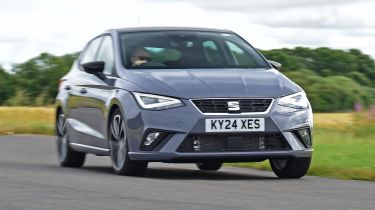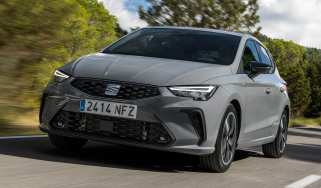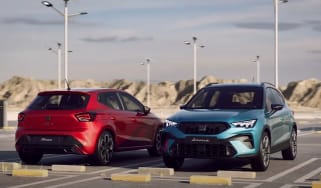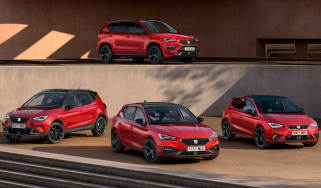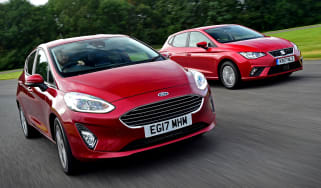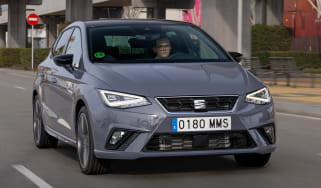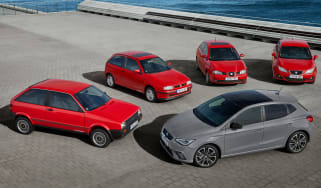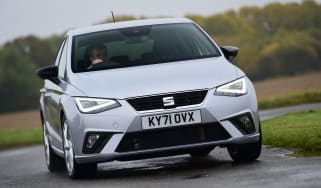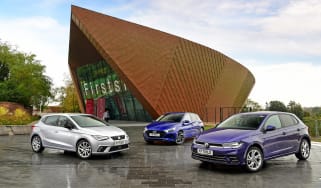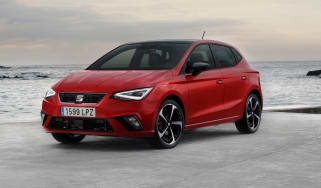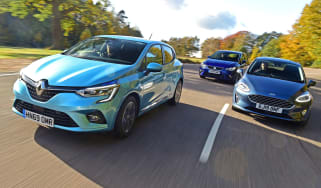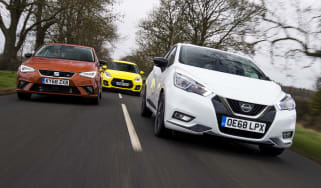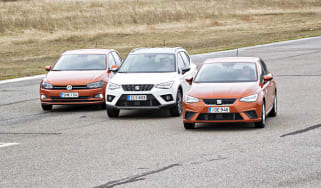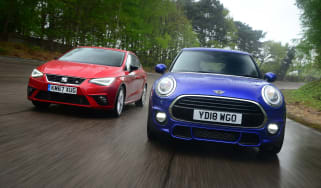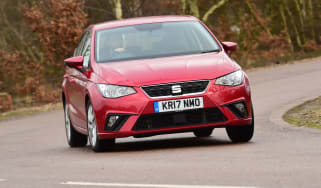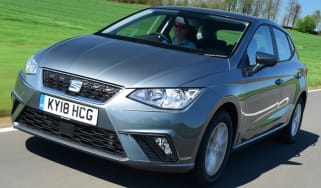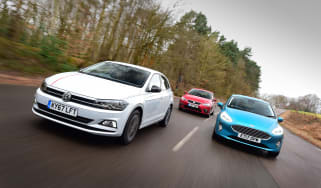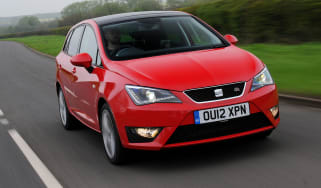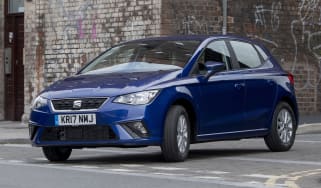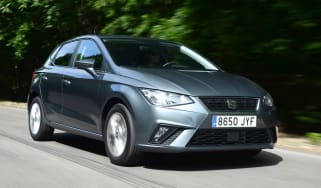SEAT Ibiza review
The SEAT Ibiza includes great on-board tech and still sets a high standard in the supermini class

In keeping with the brand’s image, the latest SEAT Ibiza has the perception of Volkswagen-like build quality and technology, coupled with some Spanish flair. The Ibiza sits as the exotic cousin of the Volkswagen Polo, and remains a solid offering in the ever-competitive supermini sector because it’s comfortable, is decent to drive, and surprisingly spacious inside.
In many ways, the Ibiza feels like a shrunken Leon (akin to how the VW Polo feels like a smaller VW Golf these days). A facelift in 2021 addressed some of the previous complaints of scratchy interior plastics and cheap-feeling cabin materials. This, along with a raft of high-end on-board tech and reasonable pricing, helps make the Ibiza a tempting proposition.
Despite its longevity (the Ibiza celebrated its 40th anniversary in 2024), the future of SEAT’s supermini has been called into question recently by VW Group boss Thomas Schäfer, although a facelift of the model should launch in 2025.
About the SEAT Ibiza
It used to sit in the shadow of rivals, but the latest SEAT Ibiza is easily one of the best superminis for sale in the UK today. It was the first small car to use the VW Group’s MQB platform, and as a result it benefits from a raft of cutting-edge tech that you would normally find on larger models.
Used - available now

2017 Seat
Ibiza
51,000 milesManualPetrol1.2L
Cash £7,450
2018 Seat
Ibiza
78,711 milesManualPetrol1.0L
Cash £7,008
2021 Seat
Ibiza
8,939 milesManualPetrol1.0L
Cash £13,323
2024 Seat
Ibiza
11,396 milesManualPetrol1.0L
Cash £16,353As with past models, the Ibiza is a sporty choice in the supermini class, even if you don't choose the racy FR or FR Sport models. The handling is sharp, but not at the expense of comfort, while increased dimensions help the Ibiza to be one of the most spacious cars in the class, too. SEAT introduced a refreshed model range in late 2021, which included minor styling tweaks and a much-improved interior with new on-board tech and smarter cabin trim.
Following the demise of the Ford Fiesta, the Ibiza does battle with the Renault Clio for the honour of being the most entertaining supermini currently on sale, while cars such as the Mazda 2 and Peugeot 208 play the sporty card. Elsewhere, the VW Polo and Citroen C3 are quality alternatives, and the Skoda Fabia, Vauxhall Corsa and Honda Jazz all offer great ability, along with the reliable Hyundai i20 and Toyota Yaris.
All SEAT Ibizas are five-door hatchbacks, with prices starting from a shade under £20,000 – roughly £1,000 less than its VW Polo cousin. With SE being the entry point to the range, there is no basic model in the line-up. All cars get alloy wheels, a touchscreen DAB radio with smartphone connectivity, metallic paint and a suite of modern safety kit as standard.
The sportier-styled FR adds LED headlights, sat-nav, 17-inch alloy wheels, a drive-mode selector and dual-zone climate control. Upgrading from FR to FR Sport results in 18-inch wheels, a digital cockpit, suede-effect upholstery and tinted rear windows. SEAT has also introduced XCellence and XCellence Lux, which add parking sensors and different exterior design.
The Anniversary Limited Edition is the most expensive version of the Ibiza, and was introduced in 2024. Setting it apart from the rest of the range is the panoramic roof, a keyless go system, an uprated sound system, a 10-inch digital driver’s display, cruise control and 18-inch wheels.
SEAT decided not to include a rapid Cupra Ibiza hot hatchback with the current-generation model, and while a punchy 1.5 TSI turbo petrol engine was offered at launch, the current powerplant range now comprises only a 1.0-litre TSI petrol engine with either 94bhp or 114bhp – the latter rising from the earlier models’ 108bhp. The 79bhp 1.0 MPI is no longer available from new.
All cars are front-wheel drive, with the lower-powered model featuring a five-speed manual gearbox. The more powerful TSI has a six-speed 'box, and it can also be had with the slick-shifting seven-speed DSG automatic.
Engines, performance and drive
The SEAT Ibiza engine range is now centred around a 1.0-litre TSI, three-cylinder petrol engine offering two different power outputs. The three-pot suits the car well, which is fortunate because the 1.5 TSI four-cylinder powerplant, which gave the car a bit of added zip, is no longer available. It’s a shame there’s no hot hatch Cupra-badged model to rival the Volkswagen Polo GTI, especially because there’s no more Hyundai i20 N or Ford Fiesta ST to battle against.
You'll notice a characteristic three-cylinder thrum under acceleration, although at cruising speeds the engine is almost entirely inaudible and smooth. The 114bhp TSI is a great all-rounder, and we think it's the best bet if you're going to be regularly carrying passengers or luggage.
Handling is strong, with the Ibiza feeling much like a down-sized Leon from behind the wheel. There's very little body roll, and while the ride is firm it isn't uncomfortable, although bigger wheels do result in a touch more road noise and vibration. The brakes are strong and inspire confidence.
The six-speed manual is pretty good and certainly more precise than the gearshift action you get from Stellantis-group cars such as the Vauxhall Corsa. If you need an auto, a seven-speed DSG dual-clutch auto is available on the 114bhp 1.0-litre car for around an extra £1,100.
0-62mph acceleration and top speed
With the demise of the painfully slow non-turbo MPI engine, it’s the 94bhp (named 95PS) turbo model capable of a 0-62mph time of 10.9 seconds that kicks off the range. It offers decent in-gear acceleration while feeling brisk enough away from standstill, too.
The higher-powered 114bhp (115PS) DSG car will sprint from 0-62mph in a reasonable 10.3 seconds – helped by its 200Nm of available torque from 2,000rpm, and it feels better suited to motorway driving.
MPG, CO2 and running costs
The SEAT Ibiza 1.0 TSI petrol engine offers good economy, even under the latest WLTP test procedure, thanks to a standard-fit stop-start function and a range of other efficiency measures.
Maximum economy (on the combined cycle) for the TSI 94bhp version is quoted at 55mpg, with the most powerful 114bhp car returning 51.7mpg in manual form and 51.2mpg when paired with the seven-speed DSG auto. However, all of these figures will be dependent on spec, because fitting larger wheels and accessories, or going for a higher trim with more kit (thus adding weight), will have a negative impact on economy.
CO2 emissions range from 117g/km for the 1.0-litre TSI SE version, to 128g/km for the 114bhp TSI variant in Xcellence Lux trim.
Insurance
The SEAT Ibiza is on par with the Renault Clio and starts in insurance group 11, before going up to group 15 for the more powerful 1.0-litre engine. Unfortunately, because the Ibiza no longer has the lower-power non-turbo 1.0-litre, it can’t match the group 3 VW Polo Life and group 4 Skoda Fabia SE Comfort.
Depreciation
Residual values for the SEAT Ibiza are in the 45-51 per cent bracket after three years and 36,000 miles, with the 115PS XCellence with a manual gearbox being the strongest performer.
In comparison, the Skoda Fabia fares better with expected resale values between 46 to 54 per cent, while the Toyota Yaris is expected to maintain between 47 to 54 per cent over the same period.
To get an accurate valuation for a specific model, check out our free car valuation tool...
Interior, design and technology
Although the current SEAT Ibiza is a fraction (2mm) shorter than the old model, the MQB A0 platform means the wheelbase has extended by 95mm, so there's much more space inside – SEAT says rear legroom is improved by 35mm, while the square-shaped boot is especially spacious at 355 litres.
More importantly, the car has got much wider – by 85mm – and it sits ever-so-slightly lower, giving it a sportier look on the road. That’s accentuated by the sharp creases along the sides, the narrow front lights with LED daytime running lights and more creases running down the bonnet. This is a seriously good-looking supermini.
The neat styling continues inside with more sharp lines around the dash and plenty of shoulder and headroom in the front and back. A six-foot passenger can just about sit behind a six-foot driver in reasonable comfort, but there’ll be plenty of room for three children across the back bench.
The facelifted Ibiza brings a revised interior and new levels of tech to help lift its appeal. Once sat in the driver's seat, you'll notice new soft-touch materials across the dash and extra chrome trim, while the redesigned air vents add LED illumination on FR and Xcellence trims. A leather-covered steering wheel and a black headlining also feature on higher-spec cars.
We found the multi-function steering wheel (controlling audio and cruise control) a little fiddly to use, but the Ibiza does keep physical dials for the air-con system, which are easier to operate on the move.
A facelifted Ibiza is coming, and as a testament to the existing car’s pleasant design, it will broadly keep the same styling.
Sat-nav, stereo and infotainment
The Ibiza SE includes a 8.25-inch touchscreen, while all other trim levels come with a 9.2-inch version. All feature Apple CarPlay and Android Auto connectivity, with integrated sat-nav available on SE Technology variants and above.
The smaller screen gets physical dials for the volume and shortcuts next to the unit, but the larger screen features a couple of touch-sensitive shortcuts running down the left-hand side of the display. These include the volume controls, but there is also a physical wheel on the steering wheel itself. Boot-up times are slow, yet once it’s loaded the system responds to commands quickly. There are areas which don’t seem particularly logical, though.
The colour display is clear and sharp, with the screen itself now in a more useful position than before, sitting slightly ahead of the dash. If you're looking for digital instrumentation, you'll need to upgrade to either the FR Sport or Xcellence Lux trims, which include the Digital Cockpit tech.
Lower down on the dash you’ll find three large rotary switches for the ventilation controls in SE spec, with FR and above getting more switches and buttons in this area. Of the two we actually prefer the cheaper trim level’s set-up.
Boot space, comfort & practicality
The SEAT Ibiza is one of the most practical and versatile cars in the supermini class. It offers plenty of passenger space and a decent boot, and there are loads of places to store odds and ends. Its dinky dimensions mean it's easy to park in town, too.
Useful features on the lower-spec SE includes automatic headlights, electrically adjustable door mirrors, a height and reach-adjustable steering wheel and a tyre pressure-monitoring system, while the more expensive Xcellence trim adds parking sensors, a keyless-go system and rain-sensing wipers.
Dimensions and size
The Ibiza is available only as a five-door, and it’s much wider, a touch lower and a fraction shorter than the previous model. It’s still just over four metres long, but the added width makes it feel like a bigger car.
Leg room, head room & passenger space
SEAT seems to have done the impossible by making the Ibiza 2mm shorter than before, yet offering much more space inside. Legroom in the back is up by 35mm, thanks mostly to the 95mm increase in wheelbase. It all equates to one of the most spacious cars in the class, with room for a six-foot passenger to sit in reasonable comfort behind a six-foot driver with plenty of head and shoulder room.
Three adults across the back will be tight, but children will be fine. Access to the rear seats is good, and the view out is impressive, too; even without a panoramic roof, the car feels light and airy. As you might expect, the only other model in the supermini class that can boast a similar amount of space is the mechanically identical VW Polo.
Boot space
The rear seats will split and fold 60:40 to increase the already impressive 355-litre luggage space. A two-stage boot floor is offered, which can either set the floor level with the sill for loading, or drop lower for maximum capacity. There are no complaints about access to the luggage space, either – the SEAT badge on the boot door doubles as the release handle, and the door swings high up out of the way.
Reliability and safety
SEAT has had a mixed time of things in our Driver Power customer satisfaction survey. Over the years, the maker has never raised itself out of the bottom half of the manufacturer ranking, although a 15th-place finish out of 30 manufacturers in the 2021 Driver Power poll of best brands was more encouraging. However, results in 2022 saw a slip back to 17th spot, with a lowly 23rd position achieved in 2023.
The SEAT Ibiza is a safe place to be, with every model featuring an autonomous emergency braking function, Lane Assist and a tiredness recognition system. SEAT does offer two individual safety packs at extra cost, with the most comprehensive option (£395) featuring adaptive cruise control, high beam assist, a road sign display and a lane keeping system with traffic jam assist.
Euro NCAP awarded the Ibiza a five-star safety rating in 2022. This included an 83 per cent score for adult occupant protection and 82 per cent for child passenger safety.
Warranty
As with rivals and other members of the VW Group, a new SEAT will be covered by a three-year manufacturer warranty with a 60,000-mile limit. This is very average for the class, and well behind the five and seven-year warranties offered by the likes of Hyundai and Kia. SEAT does offer an extended warranty option, however.
Servicing
Service intervals are every year or 10,000 miles, whichever is sooner, while SEAT offers fixed-price service plans to help manage maintenance costs.
Frequently Asked Questions
Used and nearly new SEAT Ibizas
The original SEAT Ibiza made its debut in 1984 and was the Spanish firm’s first attempt at a homegrown supermini. Up until this point the brand had effectively produced rebadged Fiat models, largely for its home market. Originally a three-door hatch it later spawned a more versatile five-door variant.
Since then there have been four more generations of Ibiza, each aiming to combine a dash of Latin design flair, with fun-to-drive dynamics and value for money pricing. From the second generation on, the supermini shared its underpinnings and engine with other models from the VW Group, which bought SEAT outright in 1990.
SEAT Ibiza Mk5: 2017 to present
The most recent Ibiza is the best yet, and the first to be a true supermini benchmark. Based on the same platform as the current VW Polo, it mixes a refined and grown-up driving experience with typically eye-catching looks and the latest tech. Available only as a five-door, it’s a surprisingly roomy and versatile small car that can easily double as family transport. The rapid Cupra models have been dropped from the range, but the sporty FR models offer warm hatch pace and engaging dynamics.
SEAT Ibiza MK4: 2008 to 2017
SEAT pulled out the stops on the style for the fourth generation machine, which was one of the most distinctive looking superminis when it debuted in 2008. In fact, despite being in production for the best part of a decade it only ever got the most minor of facelifts over the years. It was good to drive thanks to a firm suspension set-up that prioritized sharp handling over comfort, while the hot Cupra models offered lots of performance for the cash. Yet a lack of overall quality and refinement compared to similar era rivals meant the SEAT was rarely in contention for class honours. You can read our full SEAT Ibiza Mk4 buyer’s guide here. Read the full review...
SEAT Ibiza Mk3: 2002 to 2008
The first Ibiza to set the stylish and sporty tones for following models, the third generation model was penned by former Alfa Romeo designer Walter da Silva. Like it’s predecessor it was sportier to drive than many of its rivals, while once again there were hot Cupra versions, including a muscular diesel. This was also the last version of the Ibiza to include a four-door saloon Cordoba version in its line-up. Read the full review...
Older SEAT Ibiza models
The first generation Ibiza was launched in 1984 and was one of the first SEAT models not to be a re-badged version of an older Fiat. While it was loosely based on the Italian firm’s Ritmo family hatch, the three-door Ibiza was styled by Italdesign and used engines that had been massaged by Porsche (most cars had proud ‘System Porsche’ badges applied). Quality was a bit hit and miss, but the SEAT looked good and drove well, especially compared to budget rivals from Skoda and Lada. It’s popularity was boosted by a five-door version, but the Malaga four-door saloon was a slower seller.
However, it was the second generation model that made SEAT a household name, as it was the first model to be fully developed under the firm’s new owners VW. Based on an all-new platform that would go on to underpin the third generation VW Polo, the Ibiza was a much more grown-up and sophisticated car than its predecessor. It was bigger too, with a more practical interior that had a much more upmarket feel. This Mk2 machine also debuted hot GTi and Cupra versions, which effectively used 1.8 and 2.0-litre engines (both 8 and 16-valve) and suspension from the Golf GTi. The SEAT’s appeal was further broadened by the fact you could get a wide range of body styles, including three and five-door hatchbacks, a four-door saloon and even a versatile estate.

